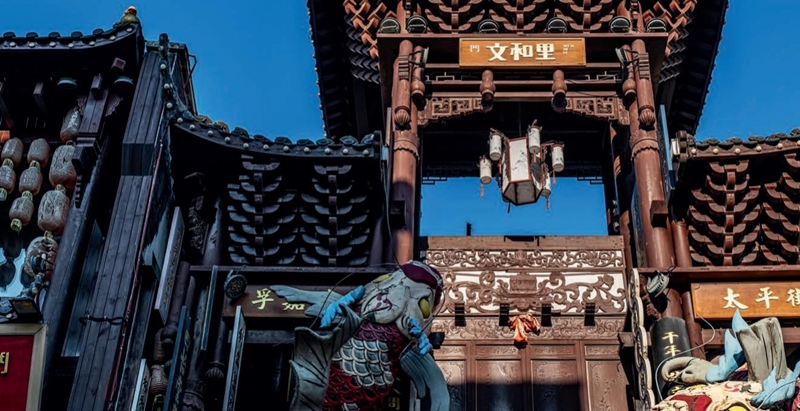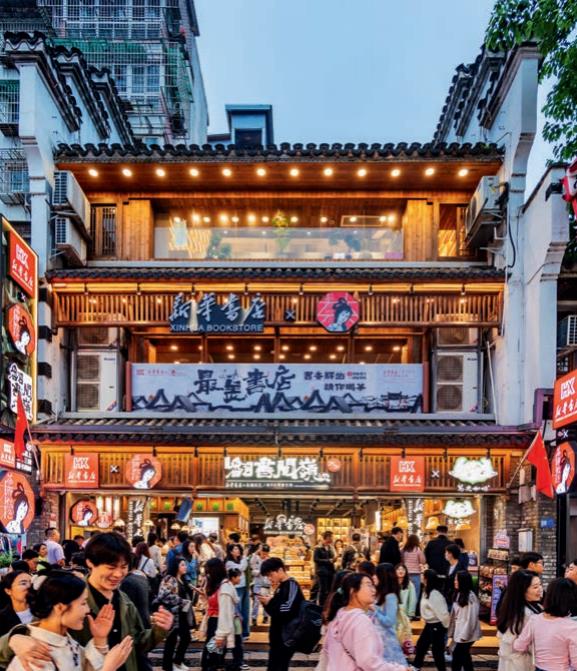New Life in Old Street

“On your first visit to Changsha, a trip to Taiping Old Street is a must.” Newcomers to Changsha in central China’s Hunan Province often hear this advice from locals.
The Taiping historical and cultural block holds a wealth of traditional architecture featuring white walls, black tiles, sloping roofs, and wooden doors and windows. Time-honored shops and former residences of celebrities are closely nestled together. Ancient opera stages, old memorial archways, and stone-paved roads weave through the fabric of the old street. All these elements, combined with trendy stores, creative landscapes, a diverse array of food options, and lively crowds, collectively create a unique atmosphere. The weight of history blends seamlessly with the vibrancy of the marketplace, radiating youthful energy from a millennia-old street.

A Window to Hunan Culture
Known as “a cornerstone of Changsha’s history,” the millennia-old Taiping Street is one of the few places in the city where ancient lanes and unique features have been meticulously preserved. The main street stretches 380 meters and is only seven meters wide. The layout resembles a fishbone pattern, with numerous winding alleys dotting the area.
With a history of more than 2,000 years, Taiping Street has served as a cultural and commercial hub in Changsha since the Western Han Dynasty (202 B.C.-8 A.D.). From 177 B.C. to 174 B.C., Jia Yi, a prominent political commentator, thinker, and literary figure of the Western Han Dynasty, held the position of Grand Tutor for the King of Changsha and resided there. Thanks to Jia Yi’s influence, Taiping Street has been revered as the “birthplace of Hunan culture.” Notable figures such as Du Fu, a famous poet in the Tang Dynasty (618-907), Zhou Dunyi, a Neo-Confucian philosopher in the Song Dynasty (960-1279), and Zhu Xi, a Chinese philosopher in the 12th century, had strong ties to this location. The area also features six protected historical sites including those associated with the Revolution of 1911, underscoring Changsha’s historical significance as the first city to echo the Revolution of 1911, led by Sun Yatsen, which sought to overthrow the Qing Dynasty (1644-1911).
Taiping Street also houses a wealth of intangible cultural heritage resources and time-honored brands. In the ancient Changsha Opera Garden, Xiang Opera, Huagu Opera, and other forms of performances that have been listed as intangible heritage take turns showcasing their artistry. At the Tianxin Intangible Cultural Heritage Protection and Exhibition Center, over 10 intangible heritage items including Hunan Embroidery, paper cutting, sugar painting, and shadow puppetry vividly illustrate the lasting allure of Hunan culture and folk customs. Where Modernity Meets Tradition
“This street has it all—food, drinks, fun activities, traditional culture, trendy creative stuff, retro things, mainstream offerings, niche items... it’s an all-in-one travel destination,” said Tan Yali, a staff member of the Taiping Street Administrative Committee. Currently, Taiping Street hosts over 400 physical stores, with creative and cultural businesses making up over 60 percent. Ninety percent of the stores operate until midnight, making it one of Changsha’s key nighttime economic hubs.
Situated at the northern end of Taiping Street, Taipingli Cultural and Creative Market is a three- story building repurposed from a sugar and liquor plant in the 1980s, accommodating over 40 innovative businesses, including the Advance Art Museum, Time Sharer Café, and the Museum of Broken Relationships. The weathered old walls, luminous courtyards, dark wooden corridors, and rows of old concrete columns, combined with contemporary art and cultural innovation institutions, create a harmonious blend of historical architecture and fresh artistic flair.
Thirty-one historical buildings on Taiping Street are home to renowned art studios, art museums, cultural and creative markets, and new catering brands like Wenheyou, Modern China Tea Shop (known as “Chayan Yuese” in Chinese), and Dim Sum Bureau of Momo. In recent years, innovative development of Taiping Street has brought a continuous stream of “new blood” that has fostered harmonious coexistence of traditional culture, modern arts, and commercial consumption in the old street, spawning new chapters of history.
Taiping Street is like a long bridge connecting the past to the present of Changsha, a vibrant city combining tradition and modernity.